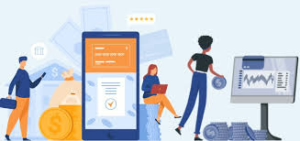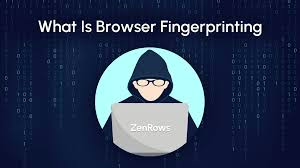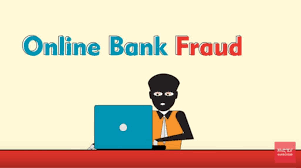In today’s digital age, safeguarding yourself against online banking scams has become increasingly vital, especially as more individuals turn to online banking services that boast high-security measures. Online banking has swiftly established itself as an essential part of modern financial management for countless people. Essentially, it refers to the ability to access the services of a bank or financial institution via your computer or mobile device. With just a few clicks, you can manage a variety of tasks, such as paying bills, receiving alerts about your account balance, sending money to friends, and transferring funds—all from the convenience of your home or while on the move.

Last year alone, it was estimated that 65% of Americans were utilising online banking services. However, this raises an important question: how secure are these financial institutions that provide online banking? Projections indicate that by 2025, nearly 217 million users will be engaging in online banking activities. If you find yourself uncertain about the safety of managing your finances online, continue reading; we aim to clarify how banks protect your sensitive data and funds while also highlighting common risks associated with online banking. Furthermore, we will discuss proactive measures you can implement to safeguard your information during your digital transactions.
To emphasise the significance and prevalence of online banking in 2023—and why security is paramount—consider three compelling statistics related to this trend. When evaluating how secure these virtual banks really are compared to their traditional counterparts with physical locations, it’s important to note that both types have implemented robust security protocols designed specifically for protecting customer information.

Among these protective measures are encryption and data protection techniques. Encryption plays a crucial role by ensuring that any data transmitted over the Internet is scrambled into an unreadable format for unauthorised users—this includes sensitive information such as login credentials and passwords. Another layer of protection comes from multi-factor authentication (MFA), which mandates users provide multiple forms of identity verification before they can access their accounts; this adds a barrier even if someone manages to obtain your login details.
Moreover, banks employ sophisticated fraud detection systems, which utilise advanced algorithms and pattern recognition technology to spot any suspicious activity within accounts promptly. As you navigate the world of online banking, understanding these security measures can empower you while also highlighting the necessary precautions you should take to protect yourself effectively in this evolving landscape.
When it comes to online banking, the security measures in place can differ from one institution to another. However, a crucial step you should always take is to ensure that the online bank you choose is insured by the Federal Deposit Insurance Corporation (FDIC). This government agency protects your deposits, guaranteeing coverage of up to $250,000 for each account holder. If you’re unsure whether a particular bank has this insurance, consider utilising the FDIC’s BankFind tool; it’s an excellent resource for verifying an institution’s FDIC status.
As you navigate the world of online banking, it’s vital to be aware of certain risks associated with this convenience. There are four key threats that every user should keep in mind: malware infections, unauthorised transactions, phishing attempts, and potential service outages. While many online banks implement strong security protocols designed to safeguard your personal information and financial data, taking proactive steps on your part is essential for ensuring your online safety.

One prevalent danger in this digital landscape is phishing. Scammers often deploy deceptive emails or messages that mimic legitimate communications from trusted sources—these are explicitly crafted to trick unsuspecting users into revealing sensitive information such as passwords or account numbers. Another significant threat comes from malware and viruses; these malicious programs can infiltrate your devices and compromise their integrity if you accidentally download infected files.
Identity theft is yet another serious concern. Should your private information fall into the hands of cybercriminals, they may exploit it to conduct unauthorised transactions or even open new accounts under your name without your consent. Additionally, consider how Wi-Fi security impacts your safety while banking online; using unsecured public networks can expose you to hackers who are eager to intercept unprotected data as it travels over these connections.

To mitigate these risks effectively requires diligence and adherence to standard security practices. By being vigilant about where and how you access your banking information—and by staying informed about common scams—you can significantly enhance your defence against potential threats. Below are some practical tips designed to help protect yourself from online fraudsters and ensure a secure experience while managing your finances through digital platforms.
Five Essential Guidelines for Secure Online Banking
In today’s digital age, the responsibility of ensuring a secure online banking experience extends beyond just your bank; it also falls on you as the user. To help you navigate this landscape and keep your personal information safe, here are five crucial guidelines that can significantly enhance your online banking security.
1. Craft Strong Passwords
A robust password serves as a primary barrier to protecting your sensitive data. To illustrate the importance of password strength, consider this: a 12-character password is estimated to take an astonishing 62 trillion times longer to crack than a mere six-character one. Therefore, it’s imperative to create complex passwords that incorporate a mix of uppercase and lowercase letters, numbers, and special symbols. Aim for at least 12 characters in length and choose phrases or words that are not readily associated with you—steer clear of obvious choices like birthdays or home addresses. If you manage multiple bank accounts, ensure each one has its distinct password to minimise risk. For convenience and security, consider using a password manager to help keep track of all these unique passwords.

2. Invest in Antivirus Software
Installing antivirus software on all your devices is essential to fortify your defences against potential threats further. While many smartphones come with built-in antivirus protection, supplementing this with additional software can provide an extra layer of security against malware and other cyber threats. When selecting antivirus solutions, look for comprehensive packages that include features such as firewall protection, VPN services, and even password management tools.
3. Implement Multi-Factor Authentication (MFA)
Multi-factor authentication (MFA) adds another layer of security by requiring more than just your login credentials to access your accounts. This could mean receiving a unique verification code sent directly to your mobile device or utilising biometric data like fingerprints for access verification. Engaging MFA is an effective strategy for enhancing account safety while banking online; it’s typically easy to enable through the settings menu of most banking platforms.

By following these straightforward yet impactful tips—choosing strong passwords, effectively utilising antivirus software, and enabling multi-factor authentication—you can significantly bolster the security surrounding your online banking activities and protect yourself from potential threats lurking in cyberspace.
4. Steer Clear of Public Wi-Fi
When it comes to public Wi-Fi networks, caution is key. These connections are frequently unsecured, making them vulnerable to potential interception by hackers. While it may seem relatively harmless to browse the internet in a café or scroll through social media at an airport, the stakes are much higher when it involves your online banking details. Therefore, it’s wise to refrain from logging into your bank account while connected to any public network. Instead, always seek out a secure and password-protected Wi-Fi connection whenever possible.
If you need to access your financial accounts while on the move, consider using your smartphone’s cellular data instead of relying on Wi-Fi—if that option is available. Additionally, employing a virtual private network (VPN) can be an excellent way to safeguard your connection by encrypting your data as you navigate online away from home.
5. Sign Up for Bank Alerts
Many banks and financial institutions offer the option of receiving notifications via email or text when certain activities occur in your account—such as when your balance falls below a specified threshold or when a significant purchase is made. By opting into these alerts, you position yourself to act quickly should any suspicious activity arise, allowing you to report potential fraud or unauthorised transactions without delay.

If, for some reason, your online bank doesn’t provide such alert services (although most do), you must remain vigilant about monitoring your account activity on a regular basis. Make it a habit to check your transaction history periodically; this proactive approach enables you to identify any unfamiliar activities promptly and take necessary action.
Cultivating Safe Online Banking Practices
In today’s fast-paced world, online banking has emerged as an increasingly popular choice for those seeking convenience in managing their finances. However, along with this ease of access come inherent security risks that accompany virtually all online activities. Fortunately, there are straightforward measures you can implement that will significantly reduce these risks.
You must take an active role in safeguarding your personal information while navigating the digital landscape of banking. By adopting sound security practices and staying informed about potential threats, you’ll be able to enjoy the advantages offered by online banking and protect yourself against possible dangers lurking within this convenient service.
Understanding Safe Online Banking: Your Essential Guide
In today’s digital age, many individuals have turned to online banking for its convenience and accessibility. However, this shift raises essential questions about security and the safety of managing finances over the Internet. If you’re contemplating opening an online bank account but find yourself uncertain about various aspects of this process, you’re not alone. Below, we delve into common concerns surrounding safe online banking.

One of the foremost issues that people grapple with is the potential risks associated with online banking. Cybersecurity threats are prevalent, and among them are phishing scams designed to trick users into revealing personal information, malware, and viruses that can compromise your devices. Data breaches pose another significant threat, where sensitive information may be exposed or stolen. Furthermore, engaging in banking activities over unsecured public Wi-Fi networks can leave your data vulnerable to interception by malicious actors.
To ensure that your chosen online bank prioritises security, it’s essential to evaluate their protective measures carefully. Look for indicators such as advanced encryption technology that safeguards your data during transmission, multifactor authentication, which adds an extra layer of verification when accessing accounts, and secure login procedures designed to thwart unauthorised access attempts. Additionally, a clear outline of privacy policies and fraud protection measures should be readily available from the institution. It’s wise to peruse customer reviews and scrutinise any fine print regarding their security practices.
When we refer to data security at banks, we’re talking about a comprehensive framework aimed at safeguarding customer information from various threats like breaches or unauthorised usage. This framework typically includes robust protocols such as encryption methods that encode sensitive data. These firewalls act as barriers against external attacks, sophisticated fraud detection systems capable of identifying suspicious activities in real-time, and stringent security measures designed to protect both the institution and its clients.

For those seeking the safest methods for conducting transactions online, several best practices can enhance your security posture significantly. Start by creating unique passwords for each account; this minimisesthe isk if one password is compromised elsewhere. Enabling multi-factor authentication adds another layer of protection by requiring additional verification steps beyond just a password when logging in. Regularly monitoring your accounts allows you to catch any unauthorised transactions early on, avoid using public Wi-Fi networks whenever possible for sensitive financial activities, keep all devices updated with the latest software patches, and stay vigilant against phishing attempts, which often come disguised as legitimate communications.
Mobile banking has also gained popularity due to its convenience but raises similar concerns regarding safety. Fortunately, if you adhere to certain precautions while using mobile devices for banking purposes—such as ensuring you have current antivirus software installed on your device—your experience can be relatively secure. Always download applications exclusively from official app stores rather than third-party sources; connect only through trusted networks; utilise biometric authentication features when available (like fingerprint or facial recognition); and exercise caution before clicking links found in unsolicited text messages or emails.
Finally, it’s crucial to ascertain whether an online bank is legitimate before entrusting it with your money. A good starting point is confirming whether they are insured by the FDIC (Federal Deposit Insurance Corporation), which provides a safety net for depositors in case of bank failure up to certain limits. Conducting thorough research into the bank’s reputation can reveal insights into its reliability—check their contact details, including physical addresses, against official records—and don’t hesitate to read customer feedback or seek recommendations from trusted sources within your network.

Navigating through these considerations will empower you with knowledge about safe practices in online banking while helping you make informed decisions regarding where you choose to manage your finances digitally.
When it comes to the question of whether online banks pose a greater risk than traditional brick-and-mortar institutions, the answer isn’t as straightforward as one might think. It’s important to understand that online banks are not automatically more dangerous than their physical counterparts. Both types of banking establishments come with their own sets of security protocols and potential weaknesses.
In fact, many online banks leverage cutting-edge technology to safeguard customer information and transactions. They often implement sophisticated security measures and have specialised systems in place that focus solely on fraud prevention. When customers adhere to recommended security practices—such as using strong passwords and enabling two-factor authentication—online banking can be remarkably secure.
Thus, while the digital landscape presents unique challenges, it also offers robust solutions designed to protect users. Ultimately, whether one chooses an online bank or a traditional bank should depend on personal preferences and comfort levels with technology rather than an assumption of inherent risk.

Maxthon
Maxthon has set out on an ambitious journey to significantly bolster the security of web applications. Fueled by a strong commitment to safeguarding users and their confidential information, Maxthon has set out on an ambitious journey. At the heart of this initiative lies a sophisticated array of encryption protocols, which serve as a robust barrier for data exchanged between individuals and digital platforms. Every interaction, whether it involves sharing passwords or personal information, is protected within encrypted channels that effectively prevent unauthorised access attempts.

This meticulous attention to encryption marks only the beginning of Maxthon’s extensive security strategy. Acknowledging that cyber threats are constantly evolving, Maxthon adopts a proactive approach to ensuring user safety. The browser is crafted to adapt in tandem with emerging challenges, implementing regular updates that promptly address vulnerabilities as they come to light. Users are strongly encouraged to activate automatic updates as a key part of their cybersecurity practices, enabling them to take advantage of the latest security patches seamlessly.
In an ever-changing digital environment, Maxthon’s unwavering commitment to ongoing security enhancements not only reflects its responsibility towards users but also underscores its dedication to building trust in online interactions. With each new update rolled out, users can navigate the web with assurance, confident that their personal information is continuously protected against new and evolving threats.
